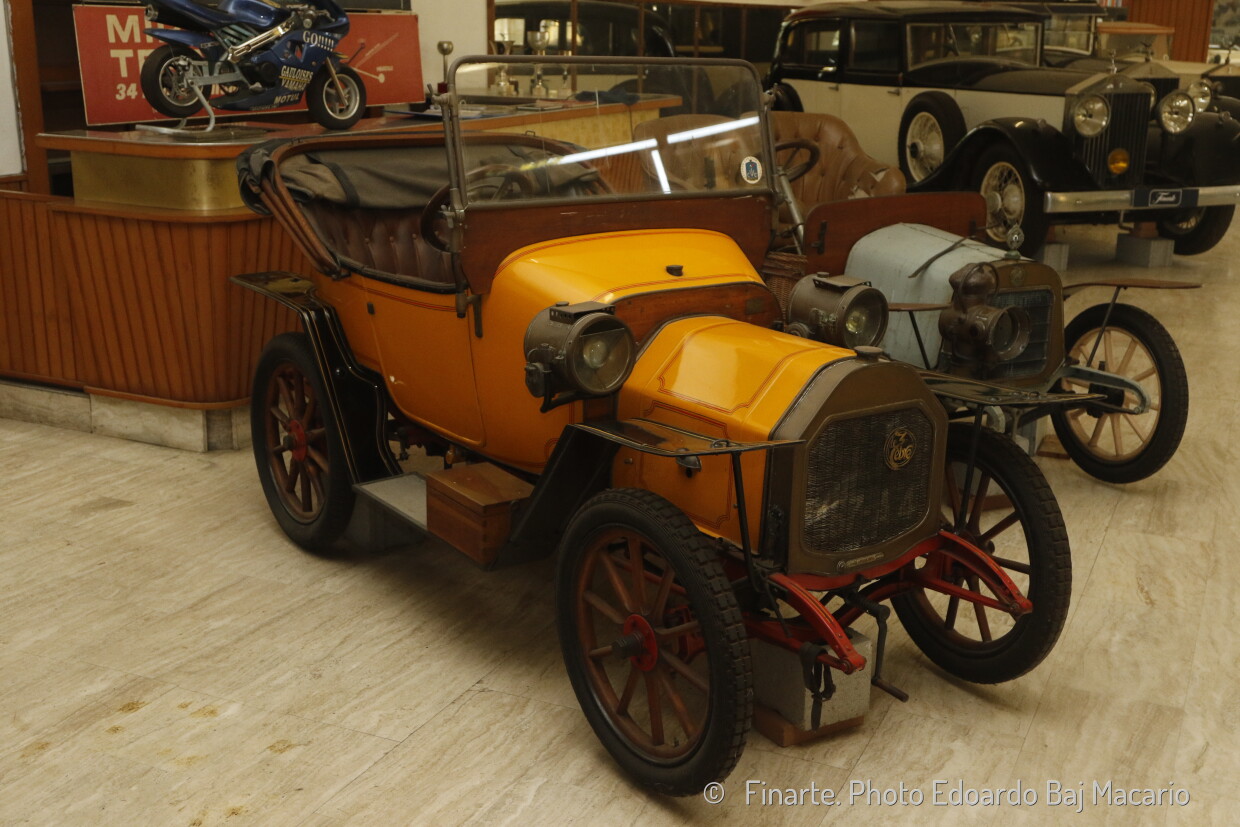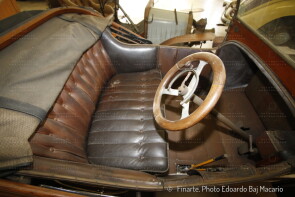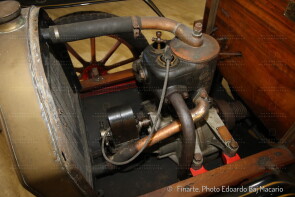
1913 Le Zèbre A
ON/OFF
Why am I an Automotive Masterpiece?
L. Limited edition cars
. A total of 1000 Type A built, the last A3 series is supposed to have been built in less than 200 units.
At the origins—or rather, the foundations—of the popular automobile, Le Zèbre would never have been born without Jules Salomon. A graduate of the École de Commerce et d'Industrie in Bordeaux, Salomon began his career gaining experience in mechanics at Rouart Frères, engine makers, where Beau de Rochas introduced him to the basics of mechanical engineering. After working for several companies, he secured a position at Brasier, owned by Georges Richard, an eclectic manufacturer of both petrol and electric vehicles. It was here that Salomon met Jacques Bizet, a commercial consultant for the company and son of the famous composer. Bizet, eager to immortalize his name to rival his father's legacy, financed and entrusted Salomon with the development of a car project. In 1908, Salomon designed the type A, which shook the market: luxury became accessible to the middle class. To avoid personal conflicts over naming rights, Salomon and Bizet decided to call the car “Le Zèbre”, inspired by the nickname of a clerk at Unic, reputed for his speed. Officially, however, the newly established company was named Bizet Constructions, initially headquartered in Paris. Shortly afterward, wealthy investors Émile Akar and Joseph Lamy joined the company’s capital. Their financial backing provided the firm with commercial stability, enabling the relocation and expansion of its factory. In 1911, the company was officially renamed the Société Anonyme des Automobiles Le Zèbre. By 1912, a second model, the type B, was introduced alongside the A. The type B featured a 10-horsepower four-cylinder engine and four seats, sold for 6,000 francs. It was soon followed by the type C, a two-seater torpedo. Production moved to a new factory in Suresnes in the département de la Seine, the so-called “berceau de l’automobile” (the “cradle of the automobile”) and later in Puteaux. The Le Zèbre cars had become synonymous with robustness, reliability, and low maintenance costs, making them unbeatable in the economy car segment. During World War I, the lightweight Le Zèbre cars proved to be “go-anywhere” vehicles, and the French government placed orders. From 1915, the Ministry of War ordered 40 vehicles per month, and Le Zèbre supplied lightweight vehicles to the French army, ensuring the company's survival during the war. However, by 1917, tensions arose between the founders, Bizet and Salomon. Just before the end of the conflict, Salomon left the company to join André Citroën in founding his namesake company, contributing to the creation of the type A Citroën, France's first mass-produced car. Several designs originating from Salomon’s time at Le Zèbre were incorporated into Citroën cars, notably the 5CV. Le Zèbre's ownership structure was restructured, and Jacques Bizet resigned from his executive position, though he retained a commercial stake in the company. Without Salomon and Bizet, however, Le Zèbre struggled to maintain its success. The withdrawal of Émile Akar and Joseph Lamy, its principal financial backers, further weakened the company. In 1924, there was a glimpse of recovery with the introduction of the type Z, developed by the English engineer Harry Ricardo, renowned for his research on combustion systems. Despite Ricardo's technical expertise, Le Zèbre’s lack of a cohesive commercial strategy led to its decline. After producing approximately 9,500 vehicles between 1909 and 1931, Le Zèbre ceased operations. Altogether, it is estimated that around 250 Le Zèbre cars survive to this day.
The “Voiturette” Le Zèbre A was designed in 1908 by Jules Salomon. It featured a 5 hp, single-cylinder engine with a 601-cc displacement (85 mm bore and 106 mm stroke), paired with a two-speed gearbox plus reverse and a shaft drive. The wheelbase measured 180 cm, and the car weighed approximately 300 kg. Initially, it was assembled at the Brasier facilities, which had become Unic in 1904. The A, designed to be cost-effective to produce, was priced aggressively: it sold for less than 3,000 francs, far below its equivalent competitors (averaging 4,000 francs) and significantly less than a mid-range automobile, which cost around 10,000 francs. This democratization of the automobile shook the market, making luxury accessible to the middle class. While some considered Le Zèbre cars closer to cyclecars than automobiles due to their compact size, the type A achieved considerable sales success, proving that the niche targeted by Salomon and Bizet was perfectly chosen. The car, offering respectable performance and low running costs, was well received by the public and soon attracted investment from influential businessmen Émile Akar and Joseph Lamy. Until 1912, Le Zèbre produced only the type A, which continued to thrive thanks in part to an extensive promotional campaign led by Baudry de Saunier (editor-in-chief of Omnia magazine), the most influential automotive journalist of the era. The car underwent several evolutions throughout its production, resulting in multiple series. The differences between the various series were rather subtle and often poorly documented, making classification complex. The main ones are: first Series (A): the original version, designed to be economical, simple, and robust. The bodywork was essential and compact, typically in a two-seater torpedo configuration. Second series (A 2): this introduced some aesthetic and technical improvements. The modifications involved details of the bodywork and some updates to the engine while maintaining the overall design of the first series. Third series (A 3): the most evolved version. Here too, the compact dimensions and single-cylinder engine were retained, but there were updates aimed at improving efficiency and build quality. The often mistakenly cited figure of 100 type A examples produced generally refers to the initial production or that of the first series (A), which was assembled in the company's early years, between 1909 and 1912. However, between 1909 and 1917, it is believed that more than 1000 examples of the type A were produced. By 1921, with the Le Zèbre brand destabilized following the departure of key personnel, the original type A re-emerged, now delivered with the type C chassis and featuring a slightly modified body. It is believed that only a few examples have survived due to their popular nature and the owners' tendency to use them to the very end.
The Voiturette Le Zèbre A, chassis no. A3-937, is a 3rd series (A 3) and was produced in 1913. Around 1000 units of Type A have been built overall, and the last A3 series is supposed to have been built in less than 200 units. Due to its simple torpedo body configuration, it is believed to be an example coachbuilt by Le Zèbre itself. This body is made of wood and steel, painted in yellow gold with red pinstriping, featuring black fenders with yellow gold pinstriping, and a foldable black canvas top. The supporting ladder frame is painted red. The two-seater interior is upholstered in brown "tête de nègre" tufted leather, while the dashboard is made of wood. Typical for a "veteran" car but now rare and outdated are aesthetic details such as the wicker luggage and umbrella holders and technical features like brakes on the rear wheels only and acetylene headlights by Liotard Frères. The car was fully restored in 1964: the mechanics were handled by Officine G. Manzanardo, while the bodywork was completed by Carrozzeria I. Zanette in Schio, Italy. During this restoration, the engine received an aluminum cylinder, and the bore was enlarged to 89.5 mm, resulting in a displacement of 667 cc. Chassis no. A3-937 was granted an ASI homologation certificate in 1969. The car has retained its original French license plate "167 A 4", but its long history remains unknown until the late 1960s, when it was purchased by the car museum of the "Terme Idroterapiche delle Saline di Miradolo" spa complex. There, it was displayed statically for almost 50 years. On November 14, 2022, the car was auctioned at “Finarte 2022: Automobili da Collezione”, along with other cars from the museum collection. After decades of inactivity, it required restoration but was found in good overall condition. On this occasion, the Le Zèbre A was sold to a private collection.




